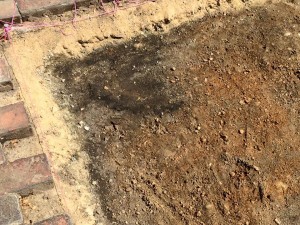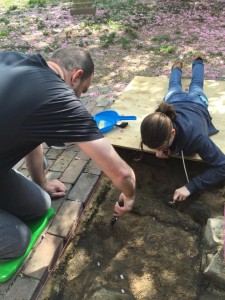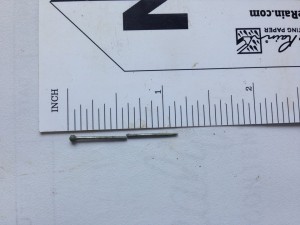On May 8th, we returned to the field for our second-to-last day of excavation (for the semester) at Old Swedes Church. Each team has continued to make excellent progress, and there is much to report, including some new types of artifacts and the use of a new excavation technique by one of our teams.
For the past two weeks, our blog has reported on features uncovered in a charcoal/ash-rich soil layer in the EU located at the northeast corner of the church. This week, the team that is working at the southwest buttress excavated two features in a compositionally similar layer of soil. Unlike the clear evidence of planks and shingles identified in the features on the north side of the church, the southwest buttress unit’s features were much less regular, and the team is still working to determine what they mean in regards to our interpretation of the site.
The team at the northeast corner EU, meanwhile, continued to work to carefully excavate the charcoal layer at their site—this time using a new technique: “spooning.” Spooning is the term used to describe the use of spoons to carefully excavate a feature and determine its depth. Though we have used trowels, brushes, and hand picks, this is the first time that we have used any kind of kitchen utensil to facilitate our archaeological investigation!
Inside the south porch, the team uncovered a number of intriguing artifacts during the May 8th excavation. They include a straight with a round or ball head, a miniscule fragment from a tobacco pipe bowl, and several pieces of glass. Since most of the material evidence that we have uncovered thus far in our excavation has been limited to nails, coal clinker, and fragments of brick, May 8th’s finds were hailed as exciting signs of what is to come—hopefully additional pieces of datable material evidence! There were also some interesting discoveries at the bell tower unit, including shell mortar and a piece of wire.
We ended our day with a practice session for the six class members that were slated to present an overview of our project and the findings thus far at the Early Colonial Delaware History Symposium on Saturday, May 9th. The presentation was successful, consisting of a succinct evaluation and interpretation of our excavation along with resources for interested audience members to consult in order to remain apprised of future discoveries!
As the semester draws to a close, we have all become more proficient at each of the archaeological tasks that we have been practicing. Many of the students have reported feeling excited and accomplished as they work to unearth new levels in collaboration with their team members, and some students have even become confident enough to demonstrate their new skills on camera for the documentary that is being created to tell the story of our excavation. Be sure to check this blog next week for our final update from the field!



